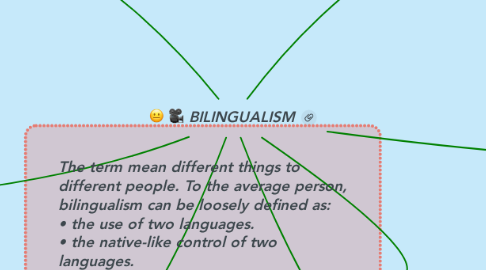
1. SOCIAL ORIENTATION
1.1. Attitudes of bilinguals toward their bilingual status;
1.2. Attitudes toward the larger community
1.3. Attitudes of the larger community toward them and their bilingual status.
2. DOMAINS OF USE
2.1. Interlocutors
2.1.1. A language relationship tends to evolve naturally. And once established, it is usually not easy to alte
2.2. Place or Location
2.2.1. work vs. home; physical location like neighborhoods
2.3. Topic
2.3.1. language of technical discourse or cooking, gardening, etc
3. AGE OF ACQUISITION
3.1. No clear cut-off age
3.2. According to many, learning a second language becomes more difficult when you are adult.
3.3. Learning a second language may be easier as a child.
4. The term mean different things to different people. To the average person, bilingualism can be loosely defined as: • the use of two languages. • the native-like control of two languages.
5. CONTEXT OF BILINGUAL LANGUAGE ACQUISITION
5.1. Primary context / natural bilingualism
5.2. Secondary context / school bilingualism:
5.3. Naturalistic fused setting:
5.4. Elective bilinguals
5.5. Circumstantial bilinguals
6. TYPES
6.1. Individual Bilingualism – the use of two (or more) languages by an individual
6.2. Societal Bilingualism – the use of two (or more) languages within a given community
7. DEGREE OF BILINGUALISM
7.1. Balanced Bilinguals
7.1.1. Individuals fully competent in both languages
7.1.2. They are considered to be almost native speaker in both language
7.1.3. Sociolinguistic forces demand that bilinguals organize their languages in functionally complementary spheres.
7.2. Dominant Bilinguals
7.2.1. Individuals who are dominant in one language
7.2.2. less dominant language = ‘subordinate.’
7.2.3. Dominance does not apply to all domains.
7.3. Passive / Recessive Bilinguals
7.3.1. Individuals who are gradually losing competence in one language, usually because of disuse.
7.3.2. common among immigrant groups
7.3.3. often loose productive skills while retaining receptive skills
7.4. Semilinguals / Limited Bilinguals
7.4.1. Correctness of language
7.4.2. Unconscious processing of language (automation)
7.4.3. Language creation

